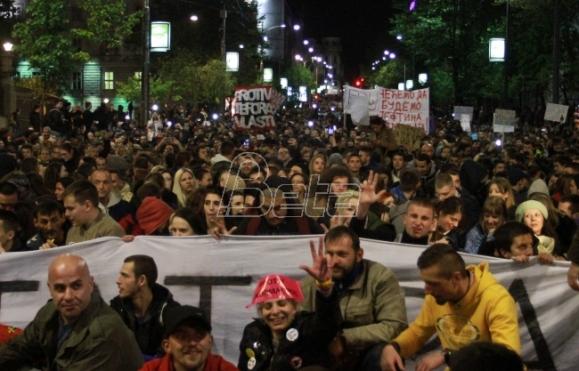
BELGRADE, 11.04.2017. – Anti-Vucic protests reveal deep divisions in the media in Serbia, with some trying to downplay the protests and accusing the opposition of planning violence on the streets.
After seven days of mass protests on the streets against the election of Prime Minister Aleksandar Vucic as Serbian President, coverage of the protests in the media, or lack of it, is seen by some as confirmation that media is not free in the country.
In an apparent attempt to downplay the size of the turnout at the rallies, the pro-government tabloid Informer on Monday published an article entitled “The Truth About the Protests” with a picture showing only a couple of hundred of people demonstrating in Belgrade on Saturday – and contrasting that with claims that 80,000 had showed up.
In another article, Informer on Sunday accused the defeated presidential candidate and former Ombudsman Sasa Jankovic of being the real organizer of the protests.
It also published what it alleged was a secret police report that claimed protest organizers were planning violence on the streets and “total chaos in the country”.
“The official information of the Interior Ministry, which we have seen, said police inspectors are warning their superiors of the more than dangerous intensions of leaders of the protests,” Informer wrote.
Jankovic has not reacted to the claim made in the paper but has supported the protests on his Twitter account.
The dailies Blic and Kurir have been reporting about the protests on their front pages, but the state-owned paper Vecernje Novosti did not mention the protests on Monday’s front page, publishing only a short news item inside the paper.
After the protesters accused Serbia’s public broadcasters Radio-Television Serbia, RTS, and Radio-Television Vojvodina, RTV, of deliberately ignoring them, both media outlets finally reported at the weekend on the rallies that have been going on for a week.
Protesters had stood in front of the TV station’s buildings with placards saying “We want live [coverage]”, demanding the resignation of the management of RTS for what they see as unfair coverage of all the candidates during the presidential campaign.
The Centre for Electronic Media and Communications NGO, which monitored the presidential campaign, said that Aleksandar Vucic had “absolute dominance” of the coverage on all national TV stations in the month before the elections.
The head of the journalists’ union at RTV, Darko Sper, at Sunday’s protest in Novi Sad, said RTV was no longer acting as a public service, accusing it of “shameful reporting”.
The protests started after Prime Minister Vucic, also head of the ruling Serbian Progressive Party, won the presidential elections on April 2 by a landslide in the first round with 55 per cent of the vote.
Jankovic came second with 16 per cent. The opposition voiced concern about election fraud before election day and Jankovic has demanded a recount, announcing that his team will file charges of irregularities.
The latest accusations of media bias follow earlier concerns about media freedom in Serbia raised by the EU, international institutions and media watchdog organizations.
A progress report on Serbia by the European Commission in November 2016 noted that Serbia had made no progress, and had made only “some level of preparation”, in terms of freedom of expression.
The report noted the role of Informer in creating what it called an environment of fear in the country.
It referred to an article published by Informer in March containing a picture of the investigative journalist Stevan Dojcinovic allegedly meeting a source for one of his ongoing stories, which it said was aimed at intimidating reporters.
There have also been questions about how the photo was acquired and whether it was done with the help of the secret police.
The UN Human Rights Committee expressed concern last month about Serbian officials vilifying and intimidating reporters and about the prosecution of journalists and civil society actors for expressing their opinions.
Another Serbian tabloid, Telegraf, has also questioned the number of protesters, publishing several pictures along with the headline “Auction With the Number of Protest Participants”.
On its front page on Monday, it published a statement allegedly made by one of the protest organizers saying they were about to give up.
The paper was mentioned in the latest report of the Serbian Press Council, a non-formal media self-regulatory body, as one of media outlets that has most frequently violated Serbia’s journalistic code.